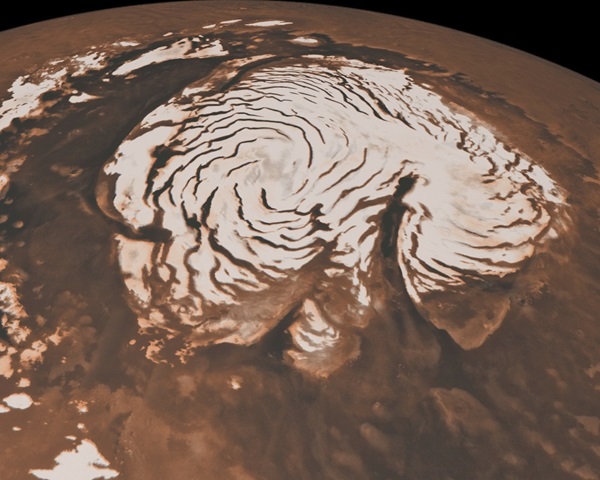Key Takeaways:
In a new article in Science, Isaac Smith and his colleagues were able to determine that the Red Planet is emerging from an ice age after many rounds of climate change chiefly by the dynamic movement of ice on the planet. These observations were found utilizing the Shallow Radar instrument on NASA’s Mars Reconnaissance Orbiter (MRO). These climate change patterns may help scientists understand climate patterns on Earth.
The Shallow Radar instrument on the MRO uses radio signals that get beamed down onto the ice caps of Mars, which then return to the instrument some time later. Measuring this time delay between the signals along with tracing out the entire ice cap by the orbiter, Smith and his team got a profile of the entire ice cap down to 300 meters below the surface.
“Layers tell us the history of accumulation, which is basically the history of climate,” says Smith.
As they took readings across the entire Northern ice cap they found that the top part of the ice cap was not simply changing in one spot, but was happening simultaneously everywhere.
“Things can be 1000 kilometers apart and they are still happening simultaneously,” Smith says. “This gives the idea that there was a climate change that was recorded right there at that level.”
As this level is the top layer of ice, this infers that the change is happening now. Currently, the water is tied up at the poles, but in the past it is expected that the water and ice would have been more spread out across the mid-latitude regions rather than being kept at the poles. As more of the surface of the planet is covered in ice, this increases the reflectiveness of the planet, causing more sunlight to be reflected back into space and for the overall temperature of the planet to decrease.
“If you looked at Mars during this period, it would be more white than red,” says Smith. “Its color would change.”
Another factor that forces climate change on Mars are Milankovitch cycles. These are cycles that affect the axial tilt and elongation of the orbit. As Mars’ axial tilt can vary from zero to 60 degrees, while the Earth’s stays steady at 23 degrees, these changes can affect how much light reaches the poles or equator of Mars. The elongation of Mars’ orbit has the same effect, as the planet can be closer or further away from the sun determining the amount of light reaches the surface.
“Really light is the biggest energy in the equation,” says Smith. “That is what causes the ice ages, the change in light.”
Smith and his colleagues still have a lot of research to conduct on the ice caps of Mars. As the Northern ice cap is 2000 meters thick, the next step is to probe even deeper to see if they can find similar signatures, says Smith. After receiving more radar data from the MRO, they want to begin to look for climate change in these deeper layers. There is current research looking at the mid-latitude ice and are finding that it is being removed constantly.
“We want to quantify how much is being removed and compare that to how much has been deposited on the poles,” says Smith.
These observations found on Mars can be applied to the Earth as well. Mars can be simplified as a laboratory for Earth as the systems that affect the planet are much simpler than Earth’s says Smith. With Earth possessing oceans and life, it complicates the model significantly. As Mars does not have these systems, Smith and his team can get a better understanding of the physics that goes into these models.
“Once we understand the physics, we can match the observations to the model,” Smith says. “We can take what we’ve learned and apply it to Earth.”










